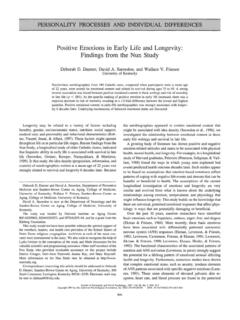Transcription of Best Practices Guide for Maintaining Aging General ...
1 Best Practices Guide for Maintaining Aging General Aviation Airplanes Endorsed by: Aircraft Owners and Pilots Association (AOPA) Antique Airplane Association (AAA) Experimental Aircraft Association (EAA) Federal Aviation Administration (FAA) September 2003 - 1 - Best Practices Guide for Maintaining Aging General Aviation Airplanes Introduction This document provides owners of Aging single-engine airplanes guidance about Maintaining the airworthiness of their airplanes. The General aviation (GA) fleet is Aging .
2 In 2000, the average age of the nation s 150,000 single-engine fleet was more than 30 years. By 2020, the average age could approach 50 years. This Guide for Maintaining older airplanes consists of best Practices that go beyond normal inspection requirements. A team made up of airplane manufacturers, owners, their representative organizations, and engineers and inspectors from the Federal Aviation Administration (FAA) developed these best Practices . The Aircraft Owners and Pilots Association (AOPA), the Antique Airplane Association (AAA), the Experimental Aircraft Association (EAA), and the FAA endorse this Guide .
3 The intended primary users of this Guide are owners of older, small single-engine airplanes. In this Guide , owners will find useful tips for assessing the effects of Aging on their airplane. They will also find that this Guide provides excellent guidance for user groups or type clubs to use for developing a checklist and gathering reference information specific to a model type. Although targeted specifically for small single-engine airplanes, much of the information in this Guide applies to the entire GA fleet. Actions owners take based on these best Practices will help protect their investment and, more importantly, help maintain the safety of their airplanes.
4 Background The GA fleet is being used well beyond the flight hours and years envisioned when the airplanes were designed. There is concern that continued airworthiness safety matters will become more common as the fleet ages. Several factors are key in keeping the existing fleet in service. Safety studies show that the biggest safety concern for GA safety is pilot situational awareness. To address this concern, modifications to the cockpit are now popular because of the rapid advances in avionics and associated affordability. A 40-year-old, four-place airplane with new avionics can remain productive for many years with periodic avionics upgrades as this technology advances.
5 These improvements will increase safety and allow much of the existing fleet to remain in service well into the 21st century. At the same time, few cost-competitive new models are available. These airplanes could develop serious age-related problems as they continue to be used well beyond their envisioned design life. The bulk of the fleet is designed to Civil Aviation Regulations (CAR) 3 standards that were established in the 1950s or earlier. These standards lack fatigue and continued airworthiness requirements as part of their certification. Thanks to the robust designs, these airplanes show few signs of Aging .
6 However, little is known about the condition of these old airplanes and the General effects of Aging on them. - 2 - Industry and government have worked together to learn more about the effects of Aging on aircraft. The focus of their efforts has been on research and regulation that specifically applies to large transports and commercial operations. However, the physics of Aging ignore regulatory boundaries. Through this effort, industry has learned much about corrosion, metal fatigue, inspection techniques, and wiring deterioration. Much of this knowledge can benefit GA.
7 Methods for mitigating the effects of airplane Aging parallel those used in medicine. Advances in medical science continue to result in new methods of detecting precursors to serious health problems. Health professionals recommend increasingly more intrusive inspections as people age. People accept these recommendations and generally request more thorough physicals as they get older. Conversely, most small airplanes, regardless of age, are rarely (if ever) inspected beyond a non-intrusive annual or 100-hour inspections as required by 14 CFR , Appendix D.
8 Purpose The recommended best Practices contained in this Guide are similar to suggested physical exams that doctors recommend. Each airplane ages differently depending on how it is maintained and used over its life. However, airplane design concepts are similar from model to model and from manufacturer to manufacturer. Therefore, these best Practices generically apply to all GA models regardless of manufacturer. This Guide explains the importance of reviewing the airplane s maintenance records. It gives some ideas for doing it and contains references that provide additional detailed information.
9 It also provides sources of information specific to particular airplane types. The owners of older airplanes routinely form organizations, especially when the manufacturer no longer exists or provides little customer support. These organizations (referred to as type clubs ) share information and are often considered the best source of continued airworthiness concerns that could be or develop into safety problems. This Guide provides a baseline airplane-wide checklist of potential Aging concerns for critical areas of an airplane. Included in this Guide is an example of such a maintenance and inspection checklist with reference information for a specific airplane model.
10 This example shows how these best Practices can be used. Best Practices Many Aging aircraft designs that are still capable of safe and useful operation in today s environment have manufacturers that have gone out of business or (for other reasons) no longer exist. Other manufacturers that may still exist do not have the capability of providing field support for the Aging models. Engineering drawings, maintenance procedures, and other technical data are just not available from these nonexistent or nonsupportive manufacturers. Acquiring, organizing, preserving, and making available for easy access all data that can be found greatly increases the likelihood for improvements in the maintenance and safe operation of a particular airplane.















